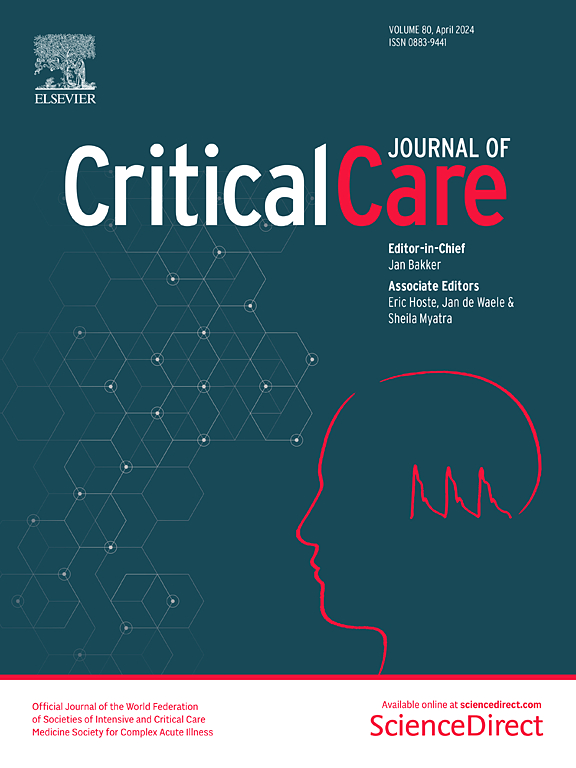Early high-sensitivity troponin elevation and short-term mortality in sepsis: a systematic review with meta-analysis
IF 8.8
1区 医学
Q1 CRITICAL CARE MEDICINE
引用次数: 0
Abstract
Serum cardiac troponin (cTn) elevation is a well-established phenomenon in sepsis. However, the clinical significance of this phenomenon with high-sensitivity (hs) assays and the current sepsis definition needs to be settled. What is the association between early serum cTn levels measured by hs-assays and the risk of short-term mortality in septic patients? We conducted a systematic review using a comprehensive PubMed, Scopus, and Embase search. Studies were eligible if they reported association data on early hs-cTn and mortality in an adult sample with sepsis that met the Sepsis-3 definition. For the synthesis of the effect of hs-cTn on mortality, we applied random effect models on the pooled unadjusted and adjusted odds ratio (OR and aOR, respectively) of elevated vs. normal hs-cTn serum values, and on the crude standardized mean difference (SMD) of hs-cTn between survivors and non-survivors. In total, 6242 patients from 17 studies were included, with short-term mortality rates ranging from 16.9% to 53.8%. Using a crude analysis, non-survivor patients showed higher hs-cTn than survivors (SMD of 0.87, 95%CI: 0.41–1.33). Elevated hs-cTn was associated with increased mortality (OR = 1.78, 95% CI: 1.41–2.25). However, this prognostic effect was absent in studies that adjusted for different confounders (aOR = 1.06, 95% CI: 0.99–1.14). Non-survivors of sepsis exhibited significantly elevated hs-cTn levels. While elevated hs-cTn levels are associated with an increased risk of mortality, they are not independently associated with this outcome in sepsis.脓毒症患者早期高敏肌钙蛋白升高与短期死亡率:系统综述与荟萃分析
血清心肌肌钙蛋白(cTn)升高在脓毒症中是一个公认的现象。然而,这种现象的临床意义与高灵敏度(hs)检测和目前的脓毒症定义需要解决。脓毒症患者早期血清cTn水平测定与短期死亡风险之间的关系是什么?我们使用PubMed、Scopus和Embase进行了全面的系统综述。如果研究报告了符合脓毒症-3定义的成人脓毒症样本中早期hs-cTn和死亡率的相关数据,则研究是合格的。为了综合hs-cTn对死亡率的影响,我们应用随机效应模型对血清hs-cTn升高与正常的合并未调整和调整的优势比(分别为OR和aOR),以及幸存者与非幸存者之间hs-cTn的粗标准化平均差(SMD)。共纳入17项研究的6242例患者,短期死亡率从16.9%到53.8%不等。通过粗略分析,非幸存者患者的hs-cTn高于幸存者(SMD为0.87,95%CI: 0.41-1.33)。hs-cTn升高与死亡率增加相关(OR = 1.78, 95% CI: 1.41-2.25)。然而,在对不同混杂因素进行校正的研究中,这种预后效应不存在(aOR = 1.06, 95% CI: 0.99-1.14)。败血症的非幸存者表现出明显升高的hs-cTn水平。虽然hs-cTn水平升高与死亡风险增加有关,但它们与败血症的死亡风险增加并不是独立相关的。
本文章由计算机程序翻译,如有差异,请以英文原文为准。
求助全文
约1分钟内获得全文
求助全文
来源期刊

Critical Care
医学-危重病医学
CiteScore
20.60
自引率
3.30%
发文量
348
审稿时长
1.5 months
期刊介绍:
Critical Care is an esteemed international medical journal that undergoes a rigorous peer-review process to maintain its high quality standards. Its primary objective is to enhance the healthcare services offered to critically ill patients. To achieve this, the journal focuses on gathering, exchanging, disseminating, and endorsing evidence-based information that is highly relevant to intensivists. By doing so, Critical Care seeks to provide a thorough and inclusive examination of the intensive care field.
 求助内容:
求助内容: 应助结果提醒方式:
应助结果提醒方式:


